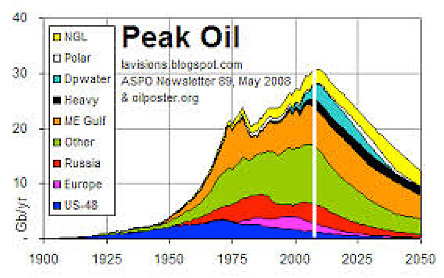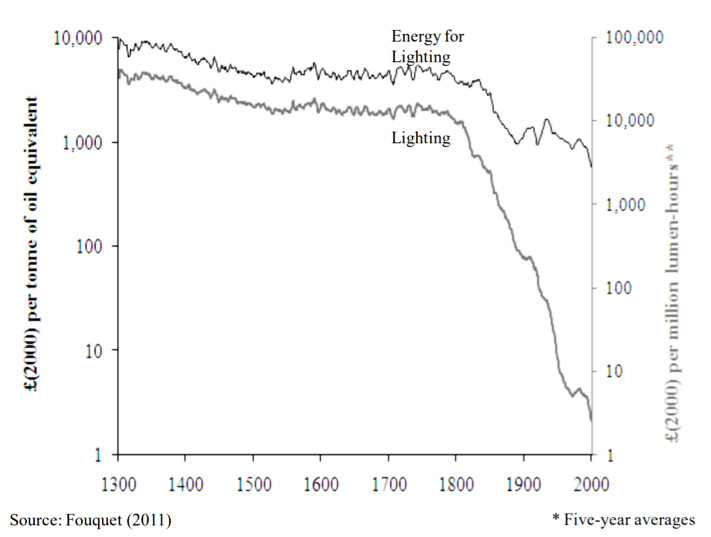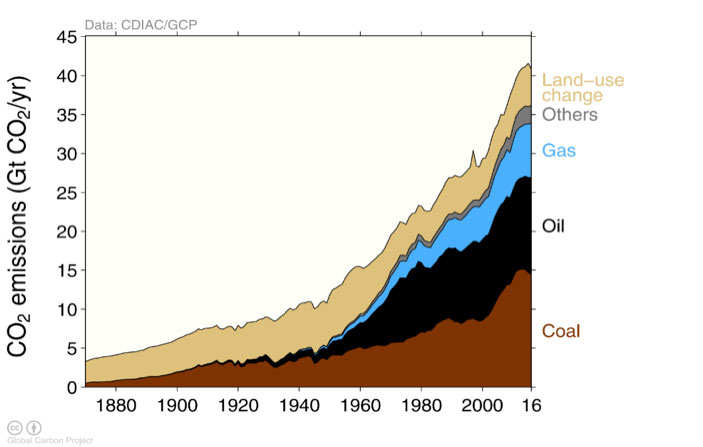The term “energy transition” has been so broadly used as to render its meaning ambiguous. Such lack of clarity is dangerous as it threatens to cloud over the importance of major climate issues. This article encourages us to see through certain trivial interpretations in order to better understand the real challenges of the energy transition as regards climate change.
This article was originally published in French in the Encyclopedia of Energy on June 7th 2018, under the title: La transition énergétique : un enjeu majeur pour la planète.
Given the debate surrounding the “energy transition”, the research platform La Chaire Économie du Climat published a document in 2013 entitled: “The energy transition, the ambiguities of a flexible concept”[1] (Read: Transition énergétique : un concept à géometrie variable). Since then, the use of the term has continued to spread, particularly in France, following a law passed by Parliament in 2015. It therefore seems essential, at a time when the Multiannual Energy Programming is the subject of great debate[2], to update this five-year-old study.
1. Energy transition: a malleable concept
The concept of energy transition appeared furtively in the aftermath of the first oil crisis, in a book about the diversification of the energy mix[3]. Its use declined in the 1980s, following the oil counter-shock. The term came back into vogue in the 2000s with the rise in energy prices and the awareness of climate issues.
The term is used to describe a multitude of scenarios and can be employed to justify a number of very different policies. In the United States, the energy transition aims to reduce the country’s dependence on hydrocarbon imports. The term is used to justify the large-scale deployment of shale oil and gas, which may nevertheless prolong the use of fossil fuels[4]. In the Middle East, the energy transition is meant to help cure economies of their addiction to oil rent. In emerging countries, it aims to ensure an increase in energy sources compatible with growing economies.
In Europe, the concept justifies, on paper, policies that simultaneously reduce greenhouse gas (GHG) emissions, promote renewable energy and encourage energy efficiency. But as soon as we dig a little deeper, it appears that the packaging envelops disparate national strategies: in the name of energy transition, Germany is ending its use of nuclear power, the United Kingdom is seeking to return to it, Poland is seeking to start it and France is considering ways to dilute its weight.
Such malleability in the interpretation of the concept is dangerous, as can lead to undesirable future climate scenarios. This article aims to give a rigorous definition to the concept of energy transition, based on an analysis of the functioning of energy systems and their evolution over time. We will also attempt to clarify the concept’s links with climate change. After a brief review of the components that make up an energy system and the methods behind the accounting of its supply, we will examine the four major energy transitions in world history. We will see how past transitions have consisted in the accumulation of primary energy sources and how productivity gains in the energy system at the end of the 18th century led to an acceleration of this cumulative process. We will then underscore how the unprecedented increase in global energy consumption led to a massive release of CO2 into the atmosphere, hence the particular challenge for the low-carbon transition being to decumulate these sources by renouncing fossil fuels. This 180° turn may take some time, while the stock of CO2 already accumulated in the atmosphere leaves us with very little. Redressing the discrepancy between the time that transition will take and the speed of the climate clock is the primary concern facing the low-carbon transition.
2. An in depth look at energy systems
The concept of an energy transition is often defined from the standpoint of the respective weight of the primary sources used in the system, commonly referred to as the “energy mix”. For example, the global energy system moved from traditional biomass to fossil fuels at the beginning of the last century due to the increasing contribution of coal, which accounted for 19% of the world’s primary energy use in 1870, but 47% in 1900 and 55% in 1910[5]. This criterion can also be applied to an isolated segment of the energy system: the French electricity system thus transited from fossil fuels to nuclear power over a period of about twenty years at the end of the last century.
Such a definition is often associated with a time requirement for a new primar
.y source to reach a certain weight in the system. Vaclav Smil estimates that it took more than a hundred years for coal to contribute 25% of the world’s energy supply, while it took oil just 80 years to do the same. These can be considered as rather lengthy timespans, as also highlighted by Peter Lund[6]. However, this approach is based on the dating of the departure and arrival points, the conventional nature of which are worthy of discussion, as Benjamin Sovacool points out[7].
An approach based on the energy mix is, however, an intellectual shortcut, far from reflecting the complexity inherent in energy systems and the dynamics of their transformations.
2.1. What is an energy system?
In order to understand the dynamics of energy systems, and therefore the right levers for changing them, it is necessary to have an adequate representation of them. An energy system is characterized by a set of complex interrelationships that link primary sources to end uses (Image 1).

The end use of energy refers to the energy consumption of households, businesses or communities. These uses meet multiple needs, such as travel, heating, lighting, manufacturing and other things necessary for human activity (Read: Les besoins d’énergie). There is therefore a correlation between a society’s production and consumption patterns and the amount of final energy it consumes. End uses can be associated with technologies that depend on a particular primary source. The invention of the internal combustion engine in the 1880s thus shaped the expansion of the global automotive industry and the growth of petroleum products.
A whole series of equipment and infrastructure operate upstream of end uses to transform primary sources into useful energy, to store it, and to transport it to the consumer. These links play a major role in the functioning of energy systems: without the invention of the steam engine by James Watt (1769), coal would not have developed as it did in the 19th century; without the development of the turbine by Benoit Fourneyron (1832), electricity would not have played the role it did in the 20th century.
Primary sources make up the system’s energy mix. To measure it, the amount of energy used by final consumers must be reduced to a common energy unit. Such an operation raises conversion problems, thus requiring conventions that can lead to quite different results depending on the positioning of the electricity sector in the system (Annex 1).
We can thus more rigorously characterize the concept of energy transition as the set of transformations required to significantly modify the end uses, the mix of primary sources and the transformation/storage/distribution chain of an energy system. Such a systemic vision is the basis of the work of authors such as Vaclav Smil and Robert Fouquet, and was also popularized by Jeremy Rifkin’s book on the Third Industrial Revolution [8].
As the historical analysis shows, this type of transformation, affecting both the mix of primary sources and the end uses and intermediate links of the chain, takes place over a long period of time. Its pace is hampered in particular by the inertia of the tangible and intangible infrastructure on which the system’s operation is based.
2.2. Four major historical energy transitions
The concept of energy transition can be broken down by sector, as done by Robert Fouquet[9], and by geographical area. By analysing transitions at the level of regions and sectors, Benjamain Sovacool is able to further detail the observations made by energy historians regarding the very high inertia of energy systems, and in particular the duration of time between the moment when technological innovations appear and the moment when they produce structural transformations. While very relevant for sub-segments of the energy system, these observations can be difficult to extrapolate to the global scale. However, it is this scale that is important for the climate economist.

Drawing on Vaclav Smil, we can identify four significant energy transitions in the history of human society. The first was the domestication of fire, which allowed the human species to gain a major advantage over its competitors by using this energy for cooking, heating and later melting metals (Image 2). The second was initiated by the Sumerians, who by way of irrigation were able to increase crop yields to feed domestic animals and thus allow humans to live in settled communities. In terms of energy, this revolution consisted in adding animal traction to human muscle strength; for ploughing a field or transporting crops, the yield is multiplied by a factor of 4 to 6 (Read: La consommation mondiale d’énergie avant l’ère industrielle).

The third energy transition, which began in the United Kingdom at the end of the 18th century, increased the amount of energy used due to the extensive use of an additional primary source: coal. Coal replaced wood and human and animal muscle power around 1900 and became the world’s leading source of energy until the mid-1960s. Often presented as the energy source of the 19th century, coal did not take a significant place in the world energy system until 1880 (Image 3), even though the innovations that led to its use were available as of the middle of the 18th century. Thus, about 150 years separated the birth of the technological innovation from the moment of its massive diffusion that transformed the economic system.
The fourth energy transition was based on a cluster of innovations that appeared simultaneously during the last two decades of the 19th century and allowed for the domestication of electricity (generation, transport, lighting, and then industry) and the development of the internal combustion engine using gasoline or diesel. These are two of the three major technical innovations identified by Robert Gordon[10] and [11] in his analysis of the economic growth process. In fact, the diffusion of these innovations was at the root of successive growth waves during the 20th century. Many new goods would follow, from the washing machine (first models available in 1907 in the United States) to the computer, and all the machines that allow us to transport ourselves. Their accumulation lead to a change in lifestyle and created the conditions for mass consumption, at first limited to industrialized countries until 1950, and later extending to emerging countries. Here again, there are long decades between the emergence of technological innovations, most of which occurred before 1900, and their impact on economic growth, which became fully apparent from 1950 onwards.
3. Energy transitions of the past: a history of accumulation
The transitions of the past occured less as a succession of primary resources giving way one to another and more as an accumulation that accelerated from the end of the 18th century onwards.
3.1. Accumulation of primary sources and growth in energy consumption
A common feature of these energy transitions is that they have reproduced a cumulative scheme in which new primary sources are added to those that already exist, without replacing them. This is why the world has never consumed as much coal, the energy of the 19th century, as it has since 2000. The energy transitions since the beginning of the industrial revolution have been based on an acceleration of this longtime accumulation of primary sources, in which the earth’s inhabitants mobilize new energies without giving up the pre-existing ones (Table 1).
Table 1: Major historical transitions of the energy system: the accumulation of primary sources
| Primary sources | Processing, Storage,
Transport/Distribution |
End uses |
| Muscle energy | None | Survival |
| Muscle energy + fire | Firewood | Cooking and heating |
| Muscle energy + fire + animal traction | Firewood + livestock
|
…+transport + agricultural work + crafts |
| …+ Coal | Railway | Manufacturing (Watt machine), rail transport, shipping |
| …+ Oil and Gas
Fossils: 80% of sources |
Electricity
Transmission and distribution networks |
Combustion engine, lighting,
mass consumption, mobility of people and goods |
| Source: Authors, based on Smil (2017) | ||
A second characteristic associated with this accumulation is the increasing energy density of each newly mobilized source: for the same volume, oil provides more energy than coal, which itself provides more energy than wood. Energy densities are tied to surface area, and thus the energy transitions of the past have enabled human societies to produce more and more energy per unit of area.
The most direct consequence of the cumulation of increasingly dense energy sources is that it has led to a growth in the quantity of available energy per capita. While very slow during the first two transitions, this growth became increasingly rapid with the introduction of new fossil sources: coal, oil and gas. Coupled with the simultaneous demographic transition, this has led to unprecedented rise in global energy consumption over the past two centuries.
At the beginning of the 19th century, the world population was about 1.2 billion people, each using on average about 0.6 tonnes of oil equivalent (toe). At the dawn of the 20th century, there were 1.65 billion people with a unit consumption of 0.7 toe. Population growth coupled with the beginning of the exploitation of fossil fuels led to a doubling of total energy consumption in the 19th century (Read: Consommation mondiale d’énergie 1800-2000 : les sources d’information, Consommation mondiale d’énergie 1800-2000 : les résultats, Consommation mondiale d’énergie 1800-2000 : définitions et mesures).
The 20th century was marked by a tremendous acceleration of the energy transition, driven by the expansion of primary sources and the multiplication of uses linked to the diffusion of electricity, cars and chemicals derived from hydrocarbons. The unit consumption of the average person increased from 0.7 to 1.7 toe. As the number of people on earth has increased more than fourfold, energy consumption in the 20th century has increased ninefold.
The first fifteen years of the 21st century are a continuation of this trend, with world energy consumption increasing by just over a third between 2000 and 2015, a little faster than the world population. However, a downturn did appear from 2009, the year of the financial crisis, and continued until 2017.
This fourth energy transition is far from having provided satisfactory access to energy for all. As of 2016, about one billion people (13% of the world’s population) were still without access to electricity and nearly three billion (41% of the world’s population) were using inefficient and highly polluting cooking processes using traditional biomass[12]. Unequal access is reflected in the average figures: in 2016, an average person consumed a little less than 2 toe, but a North American 7, an Indian less than 1 and an African south of the Sahara of the order of 0.5.
3.2. Energy transitions and relative energy prices
On the economic front, the last two transitions were triggered by an accumulation of tangible and intangible capital leading to massive productivity gains spreading through the energy system. This has resulted in secular price movements affecting energy production and use.

In theory, the evolution of fossil source prices should follow an upward trajectory in the long term as the stock of the earth’s reserves becomes scarcer, in accordance with a process theorized by Harold Hotelling[13]. The observation of fossil fuel prices over the past two centuries is far from this Hotellinian model. For example, the price of oil fell relative to the general price level for a century, from the early stages of exploration in Pennsylvania until the 1970s. This decline in price was a powerful driver of its penetration into the global energy mix. The shocks of 1973 and 1980 marked the end of cheap oil and introduced a period of great price volatility. Some saw it as the harbinger of the imminence of peak oil, a juncture that has been repeatedly pushed back ever since (Image 4).
To understand the role of relative prices in a transition, observing the price of primary sources is not enough. According to Robert Fouquet and Peter Pearson, it is important to distinguish between the price of the sources used, for example the fuel for a vehicle, from the price of the services provided through these sources, like the number of kilometres that can be traveled. The difference between the two prices is a measure of energy efficiency. However, “if, over a few years, efficiency gains and therefore the difference between the price of energy and that of energy services is small, over several decades or a century, the cumulative difference between the two trends can be considerable“[14].
The case of light in the United Kingdom, carefully studied by Robert Fouquet and Peter Pearson, is particularly revealing. Until the beginning of the 18th century, the cost of light did not vary much, as the efficiency gains in the production and use of candles or oil lamps were very low. The emergence in the 19th century of new fossil sources, coupled with changes in lighting techniques, changed the situation in two ways (Image 5).

On the one hand, the shift from tallow, vegetable oils, and whale oil to town gas, kerosene and then electricity led to a decrease in the price of energy used for lighting, which fell massively between 1850 and 1920, and then slowed down and became irregular.
On the other hand, the gas burner, oil lamp, and incandescent bulb technologies that became essential in the 1930s increased efficiency gains by massively reducing the price of lighting for consumers. Unlike those observed for energy, these gains did not decline over the 20th century or the beginning of the 21st, which saw the emergence of light-emitting diode (LED) and other low-energy light bulbs.
Overall, it is the gains in the efficiency of transforming energy into light that have been the main driving force behind the diffusion of lighting via lower relative prices. In addition to those obtained in energy production, there have been significant reductions in the price of memory for our computers. It is difficult to say which is dropping the fastest: the price of the lumen or the price of the megabit!
Productivity gains in the transformation of primary energy sources into end-uses can be found in many areas: heat production, industrial processes or transport. They have played a crucial role in past energy transitions, contributing powerfully through the lowering of relative prices, to the spread of new energy uses; a spread in uses that have boosted CO2 emissions.
4. The transition of the 21st century: getting off fossil fuels
The unprecedented increase in global energy consumption has led to a massive release of CO2 into the atmosphere, a particularity of the low-carbon transition that requires the decumulation of energy sources by renouncing fossil fuels.
4.1. The accumulation of CO2 emissions
The accumulation of energy sources building up over the past energy transitions is the main cause of the acceleration of anthropogenic GHG emissions. Around 1850, it triggered an increase in the volume of CO2 emissions into the atmosphere that has lasted for more than a century and a half (Image 6).

Until 1850, biomass was the pillar of the energy system with occasional reinforcement from wind power and hydropower (mills and sailing). Its use is part of a short cycle where combustion releases CO2 previously stored in plants into the atmosphere (Read: Photosynthèse et biomasse). It can contribute to the clearing of forests, mainly for the purposes of growing crops and raising livestock, and to a lesser extent, harvesting timber. In 1850, this clearing occurred mainly in North America and Europe. It contributed more than 90% of the anthropogenic CO2 emissions, estimated at 2 tonnes per inhabitant.
Until 1950, land-use changes remained the leading source of emissions. They doubled between 1850 and 1950, the majority of deforestation at this time occurring in the United States. The locus of deforestation then shifted to tropical forests. Emissions from fossil fuel use increased rapidly until the First World War due to the spread of coal. Those from oil combustion were added from 1920 onwards, but the dynamism of emissions growth was curbed between 1910 and 1950 by the setbacks in the world economy caused by the two world wars and the 1929 stock market crash. In 1950, the average person emitted some 4.5 tonnes of CO2, half from the burning of fossil fuels or the production of cement, the other half from deforestation. 80% of these emissions came from developed countries.
The phenomenon of energy source accumulation increased from 1950 onwards. Population growth accelerated. A growing proportion of the population became able to participate in mass consumption, first in developed countries, and then in emerging countries as of the 1970s. Accumulation incorporated still new fossil sources: natural gas, and shale gas from 2000 onwards. Emissions from land-use change have stopped increasing, but the dynamics of fossil fuel accumulation are still driving CO2 emissions upwards. Four sub-periods must be considered.
The post-war era, described as a golden age by the American economist Angus Maddison[15] and the Glorious Thirties by the French Jean Fourastié[16], saw a surge in growth. Cars and trucks were essential on the roads. It was the great era of cheap oil, which replaced coal as the main source of CO2 emissions in the late 1960s. Excluding deforestation, CO2 emissions reached 4.4 tonnes per capita in 1980, almost twice those of 1950 (2.2 tCO2/person).
Between 1980 and 2000, growth began to spread to emerging economies, but the movement was hampered by the debt crisis in Latin America and the implosion of the Soviet system. In developed countries, the rise in oil prices following the oil shocks primarily benefitted natural gas (whose combustion emits on average half as much CO2 as coal to produce the same amount of energy), and to a lesser extent nuclear energy. During these two decades, the growth in emissions was less rapid than that of the population. On the threshold of the 21st century, the average person was emitting 4 tonnes of CO2, excluding deforestation.
The first decade of this century saw a massive return to coal, driven by unbridled growth in China and the needs of the electricity sector in many emerging countries, large and small (Read: Économie politique du charbon minéral). The accumulation of sources hit its peak as demand for gas and oil was driven by the strength of the economic cycle leading up to the 2009 financial crisis. In ten years, CO2 emissions from energy production and industry rose from 4 to 4.8 tonnes per capita. Economies regained the dynamism of the golden age, but with their main driving force shifted to emerging countries.
The reorientation of Chinese strategy, forced to react to the rise in local pollution, has been the major cause of the slowdown observed in the decade 2010-2020. Closures of coal mines and highly polluting factories, carbon pricing, and massive investment in photovoltaics, wind power, and nuclear power are the three ingredients. At the same time, CO2 emissions in the United States have been declining due to the shift from coal to shale gas. Overall, CO2 emissions from energy and industrial sources seemed to have stabilized at around 36 billion tonnes (4.9 tCO2/capita) between 2014 and 2016, before increasing again in 2017.
Over the past two centuries, energy transitions have triggered a cumulative mechanism of stacking new sources of CO2 emissions that has not been seen in human history. Between 1850 and 2017, the earth’s inhabitants released just over 2,300 billion tonnes (Gt) of CO2 into the atmosphere. Of these 2300 Gt, 40% have been released since 1990, and 28% between 2000 and 2017. The geography of these emissions has changed radically. Initially concentrated in Europe and North America, 80% of CO2 emissions were still emitted by industrialized countries in 1980. Their weight had fallen below 40% by 2017.
4.2. The fifth transition: decumulating CO2 emissions
In the preface to the French edition of his historical fresco on the world environment, John McNeil looks back at the main lesson learned from twenty years of university research:”…in the early 1990s, I thought that the most significant event in the world’s environmental history of the 20th century had been population growth. By the time I had finished this work, my opinion had changed and it was the fossil fuel-based energy system that I considered to be the essential variable…“[17].
If the accumulation of the three fossil energy sources was the main feature of the 20th century from an environmental and climate perspective, decumulating these sources by removing fossil fuels from our economy will be the big challenge of the 21st century. This is the main issue of the low-carbon transition, the premises of which emerged during the decade 2010-2020.
The endpoint of this fifth transition will be a system completely free of fossil sources. These are depleted as they are used and it would take millions of years for them to recover naturally. In the very long term, the scarcity of fossil fuels will result in a crippling increase in their cost, making them economically unusable. The Hotelling scheme will eventually prevail. But if the low-carbon transition is managed solely on the basis of the depletion of reserves, there is a high risk of releasing far too much CO2 into the atmosphere.
Since the two oil shocks, there have been many warnings about the imminence of peak oil leading to the inexorable decline of its exploitation. Such warnings have followed one another since those of Thomas Malthus and David Ricardo on the risk of a lack of arable land, William Stanley Jevons on the lack of coal, and then the Club of Rome on all raw materials. For two centuries, economists and politicians have been obsessed with the point at which scarcity will bring growth to an end. Pushing off this point has been a powerful driving force behind the energy transitions of the past, the success of which is largely at the root of the climate problem.
The truth is that the Earth’s crust contains far too many exploitable reserves of fossil energy relative to what the atmosphere can absorb without disrupting the climate. The major problem of the 21st century is not the risk of a lack of coal, oil, or gas. The problem is that our societies have developed over the past two centuries tremendous capacities to exploit these three energies, which are far too abundant. The energy transitions of the past have resulted from the action of humans confronted with the scarcity of fossilized carbon deposits in the subsoil. They were guided by the “carbon from below”. The climate risk forces us to consider another stock: that of “carbon from above” that accumulates in the atmosphere and disrupts the climate. The problem is no longer its rarity, but its surplus, and it must be contained to mitigate global warming.
5. Conclusion: the low carbon transition, a break from the past
While the Paris Climate Agreement does not include a binding provision to accelerate the low-carbon transition in the short term, it introduces a major innovation compared to its predecessor, the Kyoto Protocol, whose horizon was limited to five years. The agreement sets long-term objectives for the international community: on the one hand, to limit global warming “well below 2°C compared to pre-industrial levels”[18]; on the other hand, to achieve carbon neutrality by the end of the century, understood as a “balance between anthropogenic emissions and their absorption by greenhouse gas sinks“[19].
Meeting this objective will require a triple shift in the dynamics of energy transitions analysed above:
- for the historical accumulation of energy sources, it will be necessary to substitute a scheme in which decarbonized sources are no longer added to existing sources, but take the place of fossil fuels
- energy efficiency gains must not result, via the reduction in relative prices, in an increase in per capita energy consumption, which contributes significantly to the escalation of emissions
- despite the immense inertia of energy systems, this change will have to take place at the pace of a forced march, the timeframe of the low-carbon transition being subject to the tempo of the climate clock
In other words, to achieve the objectives of the Paris Agreement, it will be necessary to conduct an energy transition that, in many respects, will follow the exact opposite path compared to those taken over the past two centuries.
Appendix 1: Primary energy, final energy, electrical energy: how are they measured?
In national energy balances, a distinction is traditionally made between primary energy and final energy consumption. The term primary energy refers to the amount of energy available in its natural state before any transformation. The notion of final energy consumption refers to the energy used to satisfy the needs of final consumers after the transformation of primary energy into secondary energy. As the transformation and transport processes generate losses, the amount of primary energy that enters an energy system is therefore higher than the amount of final energy used at the output (Read: Le bilan énergétique).
In order to be able to compare different energy sources with each other, a common unit is used, the international standard of which is the joule (which represents the energy required to lift an apple one meter off the ground in a field subject to earth’s gravity!). It is therefore necessary to use conversion coefficients between the different energy sources, which are calculated according to their respective calorific content (Read: Les unités énergétiques). As a result, one kWh of secondary electricity produced from fossil fuels represents 3.6 MJ. Difficulties arise when it comes to converting kWh of primary electricity from nuclear or renewable sources into primary energy. The representation of the contribution of the different sectors to energy supply depends in this case on the accounting method used. There are several of them and the choice of method depends on conventions[20].
A first approach consists in directly accounting for primary electricity production as primary energy without distinguishing between sectors. In this case, the same conversion factor is assigned to nuclear and renewable electricity as to fossil electricity (1 kWh=3.6 MJ) regardless of the energy used and the electricity production method. This is the method used to establish the United Nations (UN) energy balances and the scenarios of the Intergovernmental Panel on Climate Change (IPCC).
An alternative approach is to account for nuclear and renewable electricity production according to the amount of fossil energy it could replace. We consider that nuclear power has an efficiency rate of 33% (only one third of the heat produced by a nuclear power plant can be transformed into electricity) or 10.9 MJ for one kWh. This approach is used in the reports published by the World Energy Council (WEC), the US Energy Information Administration (EIA) and the British Petroleum (BP) oil company. Compared to the method used by the United Nations, this approach means giving greater weight to nuclear and renewable energies in primary energy balances.
A third approach is to apply separate treatment to nuclear and renewable electricity. For nuclear power, we use an accounting method based on substitution (10.9 MJ), while the energy content of renewable electricity is considered equivalent to that of electricity produced from fossil fuels (3.6 MJ). The latter approach, the most commonly used by international bodies such as the International Energy Agency (IEA) or Eurostat, is used in this article.
The question of the method of accounting for electricity as primary energy is therefore not without consequences and influences in particular the calculation of an economy’s energy intensity. This is why energy intensity is generally measured using both primary and final energy.
Notes and references
[1] Christian de Perthuis (2013), La “transition énergétique”: les ambiguïtés d’une notion à géométrie variable, Information et Débats No. 21, Chaire Economie du Climat.
[2] Public debate on multiannual energy programming, from 19 March 2018 to 30 June 2018, https://ppe.debatpublic.fr/
[3] Lewis J. Perelman, August .W. Giebelhaus, Mickael .D. Yokel (1981), Energy Tansitions: Long Term Perspectives, Boulder : AAAS.
[4] Robert Hefner (2009), The Great Energy Transition, Hoboken, HJ Willey.
[5] Vaclav Smil (2017) Energy Transitions: Global and National Perspectives, Second edition, Praeger.
[6] Peter Lund (2006) Market Penetration Rates o Nex Energy, Energy Policy, 34: 317-26.
[7] Benjamin K. Sovacool (2017), The History and Politics of Energy Transitions, in The Political Economy of Clean Energy Transitions, Oxford University Press, (www.oxfordscholarship.com).
[8] Jeremy Rifkin (2011), The Third Industrial Revolution: How Lateral Power Is Transforming Energy, the Economy, and the World, Palgrave Macmillan.
[9] Robert Fouquet (2010), The Slow Search for Solutions: Lessons from Historical Energy Transitions by Sector and Service, Energy Policy, 38(11): 6586-96.
[10] Robert J. Gordon (2000), Does the New Economy Measure up to the Great Inventions of the Past, Journal of Economic Perspectives 14 (Vol. 14, No. 4).
[11] Robert J. Gordon (2012), Is US Economic Growth over? Faltering Innovation Confronts the six Headwinds, CEPR, Policy Insight N°63.
[12] IEA, IRENA, World Bank and WHO (2018), The Energy Progress Report, (https://trackingsdg7.esmap.org/).
[13] Harold Hotelling, “The economics of exhaustible resources”, The Journal of Political Economy, 1931, 39, pp. 137-175.
[14] Roger Fouquet & Peter J.G. Pearson (2012), The Long Run Demand for Lighting: Elasticities and Rebound Effects in Different Phases of Economic Development, Economics of Energy & Environmental Policy, Volume 1, Issue 1, P.85.
[15] Angus Maddison (2001), The World Economy: A Millennial Perspective, OECD.
[16] Jean Fourastier (1979), Les trente glororiuses : ou la révolution invisible de 1946 à 1975, Fayard.
[17] Jonh R. McNeil (2010), Du nouveau sous le soleil: une histoire de l’environnement mondial au 20ème siècle, Trad., Seuil, P.6.
[18] UNFCCC (2015), Paris Agreement, Article 2,1-a, (https://unfccc.int/sites/default/files/english_paris_agreement.pdf)
[19] UNFCCC (2015), Paris Agreement, Article 4.1 (https://unfccc.int/sites/default/files/english_paris_agreement.pdf)
[20] For a detailed presentation of the methods for accounting for primary energy supplies, refer to Mathieu Ecoiffier’s article, “Une analyse de la baisse des émissions de CO₂ dues à la combustion d’énergie en France depuis 1990”, INSEE, December 2017. A discussion of the implications of his methods on the construction of energy balances and Marcel Boiteux’s point of view are given in Jean-Pierre Hansen and Jacques Percebois’ book, “Energie : économie et politiques”, De Boeck 2015.
The Encyclopedia of Energy is published by the Association des Encyclopédies de l’Environnement et de l’Énergie (www.a3e.fr), contractually linked to the University of Grenoble Alpes and Grenoble INP, and sponsored by the Academy of Sciences.
To cite this article, please mention the author’s name, the title of the article and its URL on the Encyclopedia of Energy website.
The articles of the Energy Encyclopedia are made available under the terms of the Creative Commons Attribution – No Commercial Use – No Modification 4.0 International license.
Translated with www.DeepL.com/Translator (free version).


